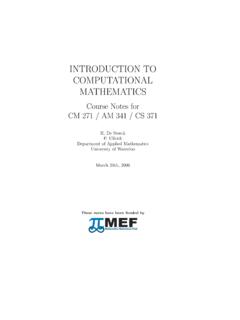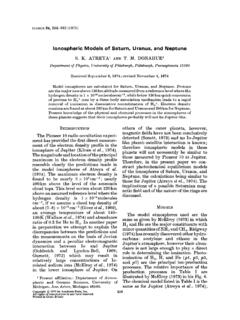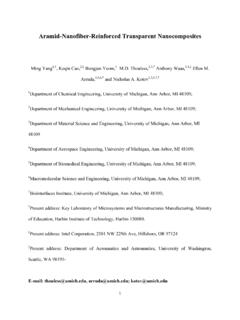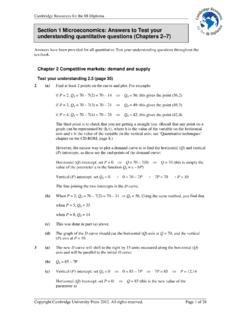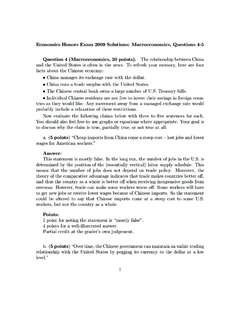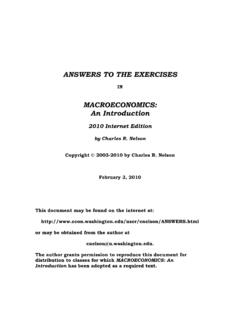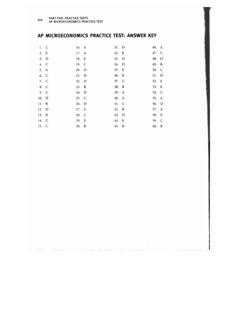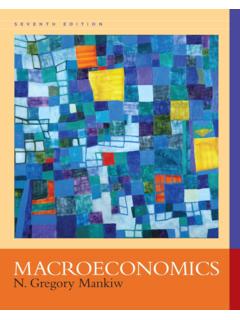Transcription of SPP/Econ 556 Macroeconomics Final Exam - Answers
1 SPP/Econ 556 Alan DeardorffWinter Term 1999 Final Exam ( with Answers )Page 1 of 12 Name:Student No.: SPP/Econ 556 MacroeconomicsFinal Exam - AnswersApril 26 & 29, 1999 Answer all questions, on these sheets in the spaces or blanks provided. In questions whereit is appropriate, show your work, if you want partial credit for an incorrect values of the questions are shown; there are a total of 85 points (10 points) In the long-run, closed-economy model of Mankiw s Chapter 3, comparethe effects on GDP, Y, and on the real interest rate, r, of the policies listed is, consider the model whose components are:Production Function:),(LKFY=(1)Wage:),(LKFMPLWL==(2 )Consumption:)(TYCC =(3)Investment:)(rII=(4)Goods Market Equilibrium:GICY++=(5) with endogenous variables Y, W, C, I, and r and exogenous variables K, L, T, Gand implicit shift parameters for each of the functions.
2 (Assume, as is explicit abovebut may seem odd below, that the capital stock, K, is not, in the time horizon of themodel, changed by investment, I.)Now determine the effects on Y and r of the following four policies:Policy 1:Government increases its purchases, G, by $1 m, spending this onenvironmental cleanup. That is 1= G and 0= = = 2:Government decreases taxes, T, by $1 m. That is 1 = T and0= = = 3:Government offers a tax credit to firms, causing them to increase theirlevel of investment, I, by $1 m for any given level of the interest rate.(Remember, this investment does not change the level of the capitalstock, K.)
3 That is 1= I and 0= = = = 4:Government spends $1 m directly increasing the capital stock, K, buthaving done so, continues with its levels of purchases and taxesunchanged. That is 1= K and 0= = = 556 Alan DeardorffWinter Term 1999 Final Exam ( with Answers )Page 2 of 12In the space below, use the above model and your knowledge of the functionsinvolved to rank these policies, relative both to each other and to zero, in terms oftheir effects on Y and r. Record your Answers either as strings of inequalities andequalities ( , 42130xxxx >= = > ), or by filling in the tables at the bottom ofthe page with the signs >, <, or =.
4 If you don t fill in the tables, we will do it for you,based on your strings of inequalities and equalities. If you do fill in the tables, we willgrade that, not the strings. You will get one-half point for each cell of the table that isfilled in correctly (by you or by us). You need not show your work on this one, andyour credit will not be affected by it if you : Policies 1, 2, and 3 leave K and L unchanged, and therefore (from (1))do notchange Y. Policy 4 increases the capital stock, thus increasing Y. So12340 YYYY = = => .As for the interest rate, that depends on the amount by which investment, I, must bechanged in order to clear the goods market in (5).
5 For policy 1, since Y and thereforeC do not change, I must fall by the same amount that G increases, therefore requiringsome particular increase in r, 01> r. For policy 3, the investment function shifts upby 1= I which is the same amount as the increase in government purchases in policy1. Here, since Y, C, and G are all unchanged, the interest rate must rise to bring I alsoback down to its old level, and this requires the same change in r needed for policy 013> = rr. For policy 2, the tax cut increases C by the MPC times the taxcut, and thus by less than the increases in G and I in policies 1 and 3.
6 So investmentmust fall, but by less, and therefore 120rr < <. Finally, for policy 4, Y increaseswithout any change in G. The increase in Y increases C but by a smaller amount (theMPC), leaving a gap that must be filled, this time, by an increase in investment. Sothis time the interest rate falls. Combining all this:42310rrrr >> > = ?Y1=?Y2?Y1=?Y3?Y1<?Y4?Y1=0?Y2=?Y3?Y2<?Y4?Y2=0?Y3<?Y4?Y3=0?Y4>0?r1>?r2?r1=?r3?r1>?r4?r1>0?r2<?r3?r2>?r4?r2>0?r3>?r4?r3>0?r4<0 SPP/Econ 556 Alan DeardorffWinter Term 1999 Final Exam ( with Answers )Page 3 of 122. (10 points) Below are shown Solow-style diagrams for analyzing the growth of threeeconomies, A, B, and C.
7 All share the same production function, f(k), the same 10%depreciation rate for capital, and the same initial condition: the capital-labor ratio differ, however, in their savings propensities, si, and their population growthrates, ni. Country A has a 50% savings rate and a 4% population growth B has the same population growth rate as A, but a lower savings rate, C has the same savings rate as A, but a zero population growth rate. Identifythe following:a. Which country(ies) has thehighest steady state capitallabor ratio?C (see *k)b. Which country(ies) has thehighest level of per capitaconsumption in steady state?
8 C (see * LC)c. Which country(ies) has thehighest growth rate of total (notper capita) income in steadystate?A and B (= n = 4%)d. Which country(ies) has thehighest growth rate of thecapital-labor ratio, k, initially?C (see k&)e. Which country(ies), if any,could increase its steady-stateper capita consumption bysaving less?C(see golden rule kg)f(k)kf(k)sB f(k) = (k)(dB+nB)k = ( + )kk0f(k)kf(k)sA f(k) = (k)(dA+nA)k = ( + )kk0f(k)kf(k)sC f(k) = (k)(dC+nC)k = ( + )kk0B:C:A: gAAkk=* Rulef ' = d+n *ALC 0k& *Bk gBk *BLC *Ck0k& *CLC gCkSPP/Econ 556 Alan DeardorffWinter Term 1999 Final Exam ( with Answers )Page 4 of 123.
9 (10 points) Mankiw s Open-Economy Long-Run Model isYFKL=(,)(1) Production Function, fixed factor endowmentsCCYT= ()(2) Consumption Function, fixed taxes,0<C =MPC<1 IIr=()(3) Investment Function, I <0 YCIGNX=+++(4) Supply and demand for goodsrr=*(5) Real interest rate pegged to world capital marketNXNX=() (6) Net exports depend negatively on real exchangerate, NX <0 Suppose that the consumption function now shifts down, due perhaps to a worseningof consumer confidence. That is, for every level of disposable income, consumerswant to consume less. Work out and explain the direction of the effect of thischange on each of the following variables of the model:Y:No change.
10 Output continues to be determined by the available quantities offactors of production, K and L, which are exogenous in this model and notchanged by a shift in the consumption :Falls. Since Y and T have not changed, the downward shift in theconsumption function is enough to assure that consumption itself is :No change. I depends on the interest rate, which hasn t changed :No change. The domestic interest rate is equal to the world interest rate,which has not :Rises. From (4), NX=Y C I G, and on the right-hand-side, only C haschanged, falling as noted above.





